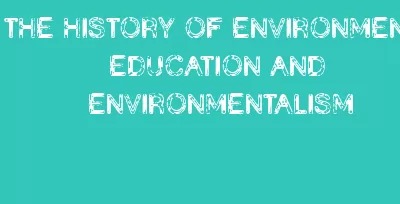Connect with me
profile/3450IMG_20230520_121000_218.jpg
Ngetichkyp

THE HISTORY OF ENVIRONMENTAL EDUCATION AND ENVIRONMENTALISM
~3.3 mins read
The roots of environmental education can be traced back as early as the 18th century when Jean-Jacques Rousseau stressed the importance of an education that focuses on the environment in Emile. Several decades later, Louis Agassiz, a Swiss-born naturalist, echoed Rousseau's philosophy as he encouraged students to “Study nature, not books.†These two influential scholars helped lay the foundation for a concrete environmental education program, known as nature study, which took place in the
late 19th and early 20th century.
Rachel Louise Carson (May 27, 1907 – April 14, 1964) was an American marine biologist and conservationist whose book Silent Spring and other writings are credited with advancing the global
environmental movement. Carson began her career as an aqua ic biologist in the U.S. Bureau of
Fisheries, and became a full-time nature writer in the 1950s. Late in the 1950s, Carson turned her attention to conservation; especially environmental problems that she believed were caused by synthetic pesticides. The result was Silent Spring (1962), which brought environmental concerns to an
unprecedented share of the American people. Although Sile Spring was met with fierce opposition by chemical companies, it spurred a reversal in national pesticide policy, which led to a nationwide ban on DDT and other pesticides, and it inspired a grassroots environmental movement that led to the creation of the U.S. Environmental Protection Agency. To Carson, a biologist, “man’s assaults upon the environment,†whether through pesticide pollution or nuclear testing fallout, was the “chain of evil.†In 1962, she sounded the alarm in her poignant Silent Spring, which resonates still, 50 years after its
publication. “Rachel Carson is properly considered the go other of the environmental movement, the founding figure and Silent Spring is one of the founding texts,†Even Cars, on’s contentions that synthetic
pesticides were unprecedented in their capacity to disrupt the balance of nature and were paving the way to cancer, the epidemic was hardly original. Indeed, fears of the lethal impact of older ‘natural’ pesticides (‘natural’ meaning compounds based on arsenic, copper and lead) had long been raised and acted upon by numerous, writers, activists, bureaucrats, and politicians.
Through 1955 and 1956, Carson worked on, several projects in between the script for an Omnibus
the episode, "Something About the Sky" and wrote articles in popular magazines. Her plan for the next book was to address the evolution, but the publication of Julian Huxley's Evolution in Action and her difficulty
in finding a clear and compelling approach to the topic l her to abandon the project. Instead, her interests were turning to conservation. She considered an environment-themed book project tentatively entitled Remembrance of the Earth and became involved with The Nature Conservancy and other conservation groups. She also made plans to buy and preserve from development an area in Maine she and Freeman called the "Lost Woods". Carson was posthumously awarded the Presidential Medal of Freedom by Jimmy Carter.
Environmental education was globally acknowledged when the UN Conference on the Human Environment held in 1972, in Stockholm, Sweden, affirmed that environmental education must be utilized as the key to address environmental issues all around the world. The United Nations Education Scientific and Cultural Organization (UNESCO) and the United Nations Environment Program (UNEP) generated three major declarations that have guided the course of environmental education. These were namely the Stockholm declaration, the Belgrade charter and the Tbilisi declaration.
The Stockholm declaration: T, the Declaration of the United Nations Conference on the Human Environment took place between June 5th and June 16th of the year 1972. The document, consisting of 7 proclamations and 26 principles, was created in order “to inspire and guide the people of the world in the preservation and enhancement of the human environment.â€
The Belgrade charter was held in October of 1975. This agreement was the product of the International Workshop on Environmental Education which was held in Belgrade, Yugoslavia. The foundation of the Belgrade charter was the Stockholm Declaration which was improved upon by goals, objectives and guiding principles of environmental education programs, which included the general public.
The Tbilisi declaration of October 1977, “noted the unanimous accord in the important role of environmental education in the preservation and improvement of the world’s environment, as well as in the sound and balanced development of the world’s communities.†(Tbilisi, 1977). The Tbilisi declaration not only rationalized and elucidated the Stockholm declaration and the Belgrade charter but also included new aims and objectives as well as guiding principles of environmental education. Later that year, the Intergovernmental Conference on Environmental Education in Tbilisi, Republic of Georgia accentuated the responsibility of Environmental Education in the conservation and development of the environment as a whole on a worldwide level.
Advertisement

Link socials
Matches
Loading...
